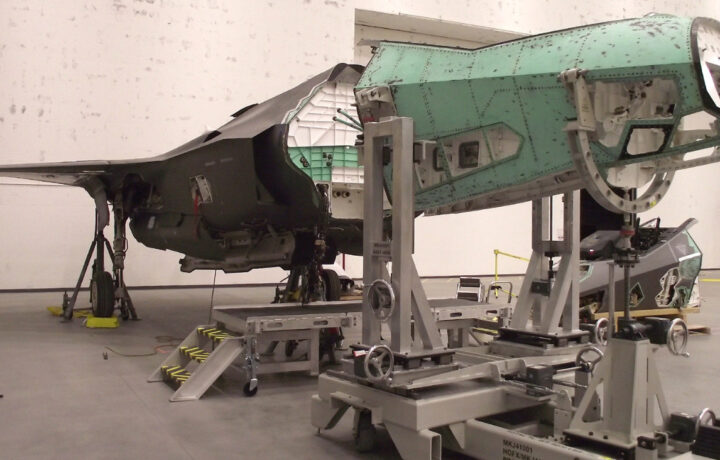In January, Hill Air Force Base (AFB), UT, announced that airmen with the 388th Fighter Wing and 4th Fighter Generation Squadron completed the restoration efforts on a very unique Lockheed Martin F-35 Lightning II. It actually involved two F-35As that were each damaged, and the maintainers successfully pieced together the structures from each of the respective aircraft generating an operational fighter plane.
Though cannibalization of aircraft is common, where old parts are taken from retired planes to keep others flying, this was considerably more challenging as it was a matter of employing significant intact portions from two aircraft.
That included the majority of the airframe from AF-211, which had experienced a nose landing-gear separation in June 2020, receiving an undamaged nose section from AF-27. The latter F-35 suffered a serious engine fire that burned the rear two-thirds of the rear section six years earlier while the aircraft was at Eglin AFB, Florida. Until it was called to donate its nose section, it had been serving as an Air Force Air Battle Damage and Repair trainer at Hill AFB.
Given the $80 million plus price tag, the decision was made to attempt what hadn’t been done before – bring together the undamaged sections of each aircraft.
As previously reported in December 2023, the project was being led by the F-35 Joint Program Office (JPO), which called upon a “dream team” of uniquely qualified individuals from the office, the fighter wing, the Ogden Air Logistics Complex, and Lockheed Martin.
“Rather than writing off both jets as a loss … teams made a bold decision in 2022 to remove the nose from AF-27 and put it onto AF-211 to maximize savings and add back an operational aircraft to the fleet,” stated a report from the F-35 JPO.
Two Become One
It likely seemed like a daunting challenge, but one that the 388th FW and 4th FGS were up to taking head-on.
“When we received the aircraft, it was pretty much a shell,” said Senior Airman Jaguar Arnold, the aircraft’s dedicated crew chief from the 4th FGS in January. “There were a lot of tasks to complete that we hadn’t done before at the unit level.”
The nearly two and a half year long restoration was completed in January, and the Franken-bird, or FrankenJet as it is also known, took to the skies and then flew to Lockheed Martin’s F-35 facility in Fort Worth, Texas, for final maintenance. It returned to operational duty at Hill AFB last month.
It marked the first time maintainers have succeeded in piecing together two different Lightning IIs to create one that is fully operational, and possibly even combat-capable. Total cost was reported to be $11.7 million, $2.8 million below the original project costs, but also far less than the cost of a brand-new F-35. It was also completed by its planned completion date.
In addition, airmen completed many first-time tasks at the field level, and they provided feedback to the JPO that will be used to update the Joint Technical Data used by all F-35 maintainers when installing and inspecting new components.
“A testament to the process developed here is that the rebuilt aircraft’s first flight was flown to the edges of the performance envelope, and it performed like it was fresh from the initial production line,” said Jeffrey Jensen, the F-35A variant lead at Hill AFB. “This aircraft will be returned to full service, ready to defend this country, and at a significant cost savings to the taxpayers.”
To date, there have been 31 crashes involving the fifth-generation stealth fighter, with the most recent being at Eielson AFB, Alaska, in January. While most of the damaged planes can’t be returned to service, this effort could allow for another look at a few of the downed F-35s to see if lightning can strike twice with another Franken-bird!




